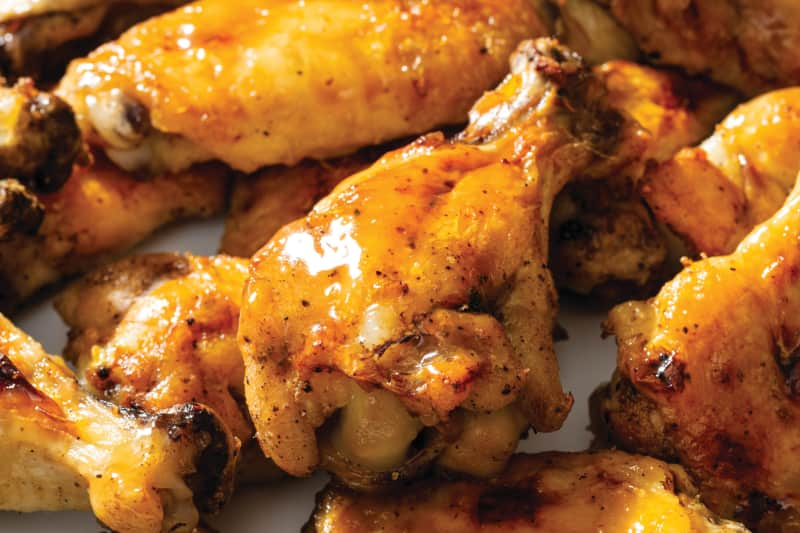My favorite part of roasted chicken has always been the wings.
Roast Your Chicken Wings in a Sheet-Pan Sandwich
Published Mar. 10, 2023.

They deliver the very essence of poultry— rich, succulent meat wrapped in bronzed, well-rendered skin. That’s because the bony appendages peek out just enough from under the body of a whole roasting bird to turn deliciously brown and savory in the heat of the oven.
Too bad there are only two per chicken—because they're also the favorite part of everyone in my family.
Wouldn’t it be great if you could produce an entire platterful of wings that tasted just like two delectable noshes from a whole bird?
Problem is, simply spreading a slew of chicken wings on a baking sheet and roasting them in a hot oven doesn’t produce anything close to those from a roasted bird. They brown unevenly and their fat is never fully rendered.
In my recipe for Roasted and Glazed Chicken Wings, I solved that problem.
Sign up for the Notes from the Test Kitchen newsletter
Our favorite tips and recipes, enjoyed by 2 million+ subscribers!
The Tastiest Part of a Roast Chicken

Wings have nearly as much fat as thighs, and their large amounts of connective tissue and high skin-to-meat ratio mean that they’re loaded with collagen. Roasted on a whole bird, the fat is slowly rendered from their abundant skin, leaving the skin lightly crisp and golden brown. As the wings roast, they are also basted in the savory jus that comes off the body of the bird, which adds even more umami richness.
A Weighty Decision
Two factors make wings pulled from a whole bird superior: First, the heft of a chicken pins the wings against the hot roasting pan, helping to render the chicken fat and brown the skin. Second, drippings from the bird bathe the wings with umami-rich juices as they roast, deepening their flavor
So, I first needed to figure out how to weigh down the wings to press them against the surface of the baking sheet. The answer was right in front of me: another baking sheet.
I spread a slew of wings (halved first at the joint) on the first baking sheet, with the thicker drumettes along the long edges of a baking sheet where the pan gets hottest. Then, I scattered the more slender flats in the middle. Finally, I set a second baking sheet on top, pressed down lightly, and roasted the assembly in a 400-degree oven.
Roasted and Glazed Chicken Wings
Forget frying. After a stint in the oven, the best part of the bird emerges fall-off-the-bone tender, with exceptionally savory, golden-brown skin.How To Cut Chicken Wings

1. Using your fingertip, locate joint between wingtip and flat. Place blade of sharp chef’s knife on joint, between bones; using palm of your nonknife hand, press down on blade to cut through skin and tendon.

2. Find joint between flat and drumette and repeat process to cut through skin and joint. Reserve wingtips.
What a difference! The top sheet encouraged better contact with the bottom sheet, enhancing browning and rendering the fat on the undersides of the wings. It also conducted heat more efficiently than the air in the oven, which improved browning and rendering of the fat on their top sides.
I evolved my method to roasting the weighted wings for 45 minutes before removing the top baking sheet and pouring off any excess juices. I flipped each piece and then briefly popped the sheet under the broiler for a final skin-browning blast of heat.
Searing the Wings in a Sheet-Pan Sandwich

To produce golden-brown wings with fat that has been well rendered, we arrange the flats, drumettes, and wingtips on a parchment paper–lined baking sheet. We then weigh the parts down with a second baking sheet (a sheet of parchment goes on first to prevent sticking).
Chicken Wings That Baste Themselves
At this point, the skin was tawny brown, the fat amply rendered, and the meat moist and tender. Yet the chicken still lacked concentrated poultry flavor.

Then, it occurred to me: I’d been draining off the incredibly tasty drippings released by the wings during roasting. Instead of abandoning those precious liquids, what if I captured them and reintroduced them as a glaze? The skin on chicken wings is full of collagen that turns to gelatin during cooking, so I hoped to produce something with real cling.
For my final test, instead of getting rid of the wingtips (I'd been removing and discarding them), I nestled the tiny bundles of skin, bone, and cartilage in among the drumettes and flats to yield as much umami- and collagen-rich jus as possible. After the parts had roasted for 45 minutes, I tipped the corner of the baking sheet over a fat separator to pour off every drop of the golden liquid. I removed the fat and then reduced the drippings to a thick glaze that I brushed onto the wings after they emerged from the broiler.
As I’d hoped, the gelatinous reduction clung beautifully to the skin, which emerged glistening and slightly tacky.
How did they taste? Awesome.
The glaze was a real breakthrough, supercharging the wings with savory flavor and I now have more than enough finger-licking, chicken-y goodness to share with everyone.

